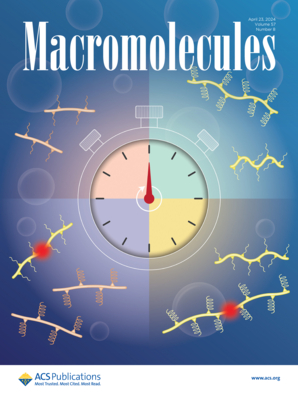Strong and Ultra-Tough Hydrogel with Hierarchical Cross-Linking Network Architecture Constructed by a Hyperbranched Topological Structure
IF 5.1
1区 化学
Q1 POLYMER SCIENCE
引用次数: 0
Abstract
Natural biological tissues such as jellyfish integrate hierarchical architectures with multifunctionality (e.g., bioluminescence, mechanical resilience, and responsiveness), yet replicating such synergy in synthetic hydrogels remains a significant challenge. Here, we present a bioinspired hydrogel engineer that employs a hyperbranched macro-cross-linker as a topological regulator to precisely manipulate the hierarchical cross-linking network architecture. Compared to the linear macro-cross-linker, the introduction of a hyperbranched topological structure has endowed the hydrogel with excellent mechanical properties. By systematically tuning branching parameters (DB and Sn), we further achieve simultaneous modulation of both the microphase separation morphology and multistage cross-linking networks. With moderate DB and Sn, the hydrogel exhibits an optimal hierarchical structure and the most uniform microphase separation, achieving the integration of excellent mechanical performance, remarkable unconventional fluorescence emission, and notable conductivity. Furthermore, the hydrogel demonstrates highly sensitive dual optical–electrical responsive behaviors when used as a strain sensor. This strategy provides a universal platform for designing hierarchical hydrogels with programmable functionality, offering promising material for advanced applications in bioelectronics and soft robotics.

由超支化拓扑结构构建的层阶交联网络结构的强力超韧水凝胶
天然生物组织,如水母,将多层次结构与多功能性(如生物发光、机械弹性和响应性)结合在一起,但在合成水凝胶中复制这种协同作用仍然是一个重大挑战。在这里,我们提出了一个受生物启发的水凝胶工程师,它采用超支化宏观交联剂作为拓扑调节器来精确操纵分层交联网络架构。与线性宏观交联剂相比,超支化拓扑结构的引入赋予了水凝胶优异的力学性能。通过系统地调整分支参数(DB和Sn),我们进一步实现了微相分离形态和多级交联网络的同时调制。在DB和Sn适中的情况下,水凝胶具有最优的层次结构和最均匀的微相分离,实现了优异的机械性能、非凡的非常规荧光发射和显著的导电性。此外,当用作应变传感器时,水凝胶表现出高度敏感的双光电响应行为。该策略为设计具有可编程功能的分层水凝胶提供了一个通用平台,为生物电子学和软机器人的高级应用提供了有前途的材料。
本文章由计算机程序翻译,如有差异,请以英文原文为准。
求助全文
约1分钟内获得全文
求助全文
来源期刊

Macromolecules
工程技术-高分子科学
CiteScore
9.30
自引率
16.40%
发文量
942
审稿时长
2 months
期刊介绍:
Macromolecules publishes original, fundamental, and impactful research on all aspects of polymer science. Topics of interest include synthesis (e.g., controlled polymerizations, polymerization catalysis, post polymerization modification, new monomer structures and polymer architectures, and polymerization mechanisms/kinetics analysis); phase behavior, thermodynamics, dynamic, and ordering/disordering phenomena (e.g., self-assembly, gelation, crystallization, solution/melt/solid-state characteristics); structure and properties (e.g., mechanical and rheological properties, surface/interfacial characteristics, electronic and transport properties); new state of the art characterization (e.g., spectroscopy, scattering, microscopy, rheology), simulation (e.g., Monte Carlo, molecular dynamics, multi-scale/coarse-grained modeling), and theoretical methods. Renewable/sustainable polymers, polymer networks, responsive polymers, electro-, magneto- and opto-active macromolecules, inorganic polymers, charge-transporting polymers (ion-containing, semiconducting, and conducting), nanostructured polymers, and polymer composites are also of interest. Typical papers published in Macromolecules showcase important and innovative concepts, experimental methods/observations, and theoretical/computational approaches that demonstrate a fundamental advance in the understanding of polymers.
 求助内容:
求助内容: 应助结果提醒方式:
应助结果提醒方式:


